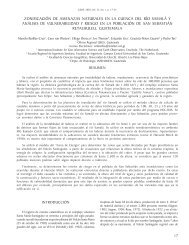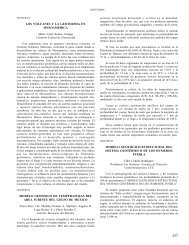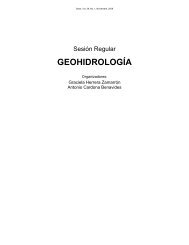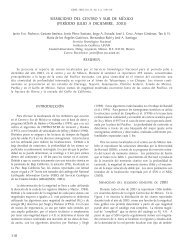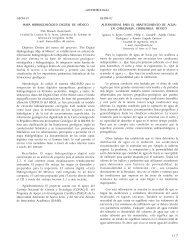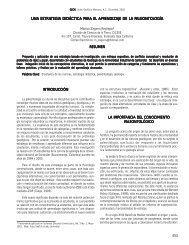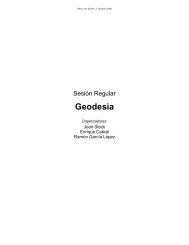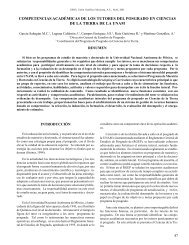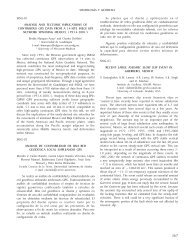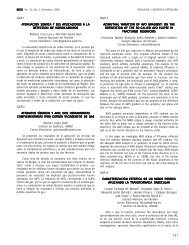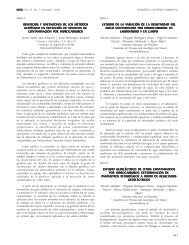Libro de resúmenes [revisión final, 172 páginas] - UGM
Libro de resúmenes [revisión final, 172 páginas] - UGM
Libro de resúmenes [revisión final, 172 páginas] - UGM
You also want an ePaper? Increase the reach of your titles
YUMPU automatically turns print PDFs into web optimized ePapers that Google loves.
CLIMATOLOGÍA, CAMBIOS CLIMÁTICOS Y ATMÓSFERA Geos, Vol. 27, No. 1, Octubre, 2007CCA-28CONSERVATIVE FULLY DISCRETE SCHEMES OFARBITRARY APPROXIMATION ORDER IN SPATIALVARIABLES FOR THE SHALLOW-WATER MODELON A DOUBLY PERIODIC MANIFOLD AND SPHERESkiba Yuri 1 y Filatov Denis 21 Centro <strong>de</strong> Ciencias <strong>de</strong> la Atmósfera, UNAM2 Centro <strong>de</strong> Computación, IPNskiba@servidor.unam.mxIt is known that the nonlinear shallow-water equations (SWEs)<strong>de</strong>scribing the dynamics of a non-dissipative and unforced fluidconserve such integral characteristics as the mass, total (kineticplus potential) energy, and potential enstrophy. However, anumerical solution requires to reduce the SWEs to a discrete form.Note that the discrete equations normally do not conserve the totalenergy and enstrophy, and the numerical solution may containadditional approximation errors and stimulate nonlinear instability.The conservation of the energy and enstrophy in fully discrete(i.e. discrete both in time and in space) schemes is especiallyimportant in the case of long-term integration.In the last forty years there have been suggested severalsemi-discrete (i.e. discrete in space but still continuous intime) SWEs that conserve the total energy and enstrophy.Nevertheless, the discretization of such equations in time usingexplicit schemes leads to a fully discrete system that normallyconserves the mass, but not the total energy and enstrophy.And even if one employs the Crank-Nicolson approximation toconserve the energy, the resulting schemes are time consumingin realization.In this work, a family of fully discrete finite difference schemesis suggested for the numerical solution of SWEs of an i<strong>de</strong>alfluid. Each scheme is or linear or nonlinear <strong>de</strong>pending on achoice of the certain parameters. The schemes can be appliedto various domains on a plane and on sphere. The method ofconstruction of schemes essentially uses splitting the operator ofmo<strong>de</strong>l in geometrical coordinates and physical processes. Thisprovi<strong>de</strong>s substantial benefits in the computational cost of solution.Moreover, when the SWM is consi<strong>de</strong>red on the whole sphere,this approach allows applying the same numerical algorithms asfor a doubly periodic domain on the plane and constructing finitedifference schemes of arbitrary approximation or<strong>de</strong>r in spatialvariables. The latter is achieved due to the joint use of thesplitting method and two different coordinate maps of the sphere.This leads to solving one-dimensional problems with periodicconditions both in longitudinal and latitudinal direction. Due tospecially chosen approximations in spatial variables, each splitsystem conserves the mass and total energy. The skillfulness ofthe schemes is illustrated by results of numerical experiments.CCA-29 CARTELON APPLICATION OF INSTABILITYCONDITIONS TO ZONAL FLOWSSkiba YuriCentro <strong>de</strong> Ciencias <strong>de</strong> la Atmósfera, UNAMskiba@servidor.unam.mxThe linear (exponential) stability of parallel (zonal) flows U(y)of i<strong>de</strong>al fluid on a plane and on a rotating sphere is consi<strong>de</strong>red.There exist three necessary (but not sufficient) conditions forthe exponential instability of zonal flows. According to the firstcondition obtained by Rayleigh (1880), the profile of velocity ofan instable flow must have an inflection point y*, in which thesecond <strong>de</strong>rivative of velocity is equal to zero: U’’(y*)=0. Seventyyears later, Fjortoft (1950) <strong>de</strong>rived a more strong condition,according to which a flow may be unstable only if the productU’’(y)[U(y)-U(y*)] becomes negative in some point of the flow.Here U(y*) is the value of velocity in inflection point. On a rotatingsphere, for zonal flows in the form of a Legendre polynomialand for the Rossby-Haurwitz waves, the third instability conditionwas obtained by Skiba (2000). The analogous conditions forthe Wu-Verkley waves and modons were <strong>de</strong>rived in Skiba andStrelkov (2000). According to Skiba’s condition, a normal mo<strong>de</strong> ofany Legendre polynomial flow of <strong>de</strong>gree n may be unstable only ifthe mean spectral number of its amplitu<strong>de</strong> is equal to n(n+1). Themean spectral number is <strong>de</strong>fined as the ratio of the enstrophy tokinetic energy.In the first part of this work, the stability of simple zonal flowson a plane is examined by using the conditions by Rayleigh andFjortoft. In the second part, the stability of a zonal flow in the formof Legendre polynomial of <strong>de</strong>gree two is analyzed on a rotatingsphere by using all the three conditions. It is shown that in thecase when the flow amplitu<strong>de</strong> is sufficiently large, the conditionsby Rayleigh and Fjortoft are satisfied, and hence the flow may beunstable. However, the use of Skiba\'s condition proves the flowstability for any its amplitu<strong>de</strong>. Thus, the given example shows thatfor certain zonal flows on a rotating sphere, Skiba’s condition canbe more strong and informative. It is shown that in the case whenthe flow amplitu<strong>de</strong> is sufficiently large, the conditions by Rayleighand Fjortoft are satisfied, and hence the flow may be unstable.However, the use of Skiba\'s condition proves the flow stability forany its amplitu<strong>de</strong>. Thus, the given example shows that for certainzonal flows on a rotating sphere, Skiba’s condition can be morestrong and informative.References:[1] Rayleigh, Lord (1880). On the stability and instabilityof certain fluid motions. Scientific Papers, Vol.3. CambridgeUniversity Press, Cambridge, 594-596.[2] Fjörtoft R. (1953). On the Changes in the SpectralDistribution of Kinetic Energy for Two-Dimensional NondivergentFlow. Tellus, 5, 225-230.[3] Skiba, Yu.N. (2000). On the Normal Mo<strong>de</strong> Instability ofHarmonic Waves on a Sphere. Geophysical and AstrophysicalFluid Dynamics, 92 (1-2), 115-127.[4] Skiba, Yu.N. y A.Y. Strelkov (2000). On the Normal Mo<strong>de</strong>Instability of Modons and Wu-Verkley Waves. Geophysical andAstrophysical Fluid Dynamics, 93 (1-2), 39-54.CCA-30 CARTELPOTENCIALIDAD DE USO DEL FRESNO FRAXINUSUHDEI PARA ESTUDIOS PALEOCLIMÁTICOSEN LA CUENCA DEL RÍO GUANAJUATOMiranda Avilés Raúl, Puy Alquiza MaríaJesús y Martínez Reyes Juan JoséFacultad <strong>de</strong> Minas, Metalurgia y Geología, Universidad <strong>de</strong> Guanajuatormiranda@quijote.ugto.mxSe analizó la potencialidad <strong>de</strong>l uso <strong>de</strong>l Fraxinus Udhei(fresno) en <strong>de</strong>ndrocronología y <strong>de</strong>ntroclimatología, <strong>de</strong>sarrollandouna cronología <strong>de</strong> ancho <strong>de</strong> anillos <strong>de</strong> crecimiento para la10


![Libro de resúmenes [revisión final, 172 páginas] - UGM](https://img.yumpu.com/51565067/10/500x640/libro-de-resamenes-revisian-final-172-paginas-ugm.jpg)
